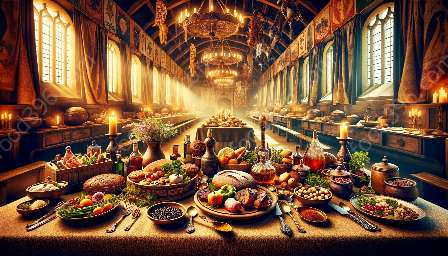Medieval cuisine was rooted in traditions that have shaped culinary history. To understand medieval cooking, it's crucial to delve into preservation and storage techniques that were central to the creation of delicious and lasting dishes. This topic cluster explores the historical relevance of preservation and storage in medieval cooking, offering insights into the techniques and their impact on medieval cuisine history.
Understanding Medieval Cuisine History
Medieval cuisine history is a remarkable journey through time, revealing the unique flavors, ingredients, and cooking methods that defined this era. The medieval period, spanning from the 5th to the 15th century, witnessed the convergence of various culinary influences, resulting in a diverse and rich food culture. The cuisine of the Middle Ages was shaped by the availability of ingredients, religious practices, social hierarchy, and the preservation and storage methods employed by medieval cooks.
Preservation and Storage in Medieval Cooking
The preservation and storage of food were crucial aspects of medieval cooking. In a time before refrigeration, preserving and storing food was essential to ensure sustenance during harsh winters and long periods of scarcity. Medieval cooks relied on a range of techniques to preserve and store food, each method contributing to the unique flavors and textures of medieval dishes.
Salting and Curing
One of the most common preservation methods in medieval cooking was salting and curing. Meat, fish, and even certain fruits and vegetables were preserved using salt to draw out moisture and inhibit bacterial growth. Cured meats such as bacon and salted fish were staples in medieval diets, providing a source of protein during times of limited fresh produce.
Smoking
Smoking was another preservation method widely employed in medieval cooking. By exposing meat and fish to smoke from burning wood, medieval cooks could impart rich, smoky flavors while simultaneously preserving the food. Smoking was a practical and flavorful technique that contributed to the development of characteristic medieval dishes.
Pickling
Using a combination of vinegar, salt, and spices, medieval cooks pickled a variety of food items, including vegetables, fruits, and meats. Pickling preserved food by creating an acidic environment that inhibited the growth of harmful bacteria. The result was a tangy, well-preserved food that added a unique dimension to medieval culinary creations.
Drying
Drying was a fundamental preservation technique in medieval cooking. Fruits, vegetables, herbs, and meats were carefully dried to remove moisture, allowing them to be stored for extended periods. The dried food items were often rehydrated and incorporated into stews, soups, and other dishes, adding depth of flavor and nutrition to medieval meals.
Fermentation
Fermentation played a significant role in preserving and enhancing the flavors of food in medieval times. Foods like cheese, yogurt, and sourdough bread were the result of intentional fermentation processes. Furthermore, fermented beverages such as ale and mead were vital components of medieval feasts, providing both preservation and enjoyment.
Impact on Medieval Cuisine History
The preservation and storage techniques in medieval cooking not only ensured the availability of food throughout the year but also influenced the culinary traditions that have endured to this day. The flavors and textures imparted by these preservation methods have become integral to the identity of medieval cuisine.
Culinary Innovation
The necessity of preserving and storing food in medieval times led to culinary innovation. Medieval cooks developed creative ways to transform preserved ingredients into delectable dishes, resulting in a diverse and rich food culture that continues to inspire modern culinary practices.
Cultural Significance
Preservation and storage techniques in medieval cooking were deeply intertwined with cultural practices and traditions. The methods used to preserve food reflected regional preferences, religious observances, and societal norms, shaping the culinary identity of different medieval communities.
Legacy in Modern Cooking
The impact of preservation and storage techniques in medieval cooking is evident in today's culinary landscape. Many traditional preservation methods, such as curing, smoking, pickling, and fermentation, continue to be celebrated in contemporary cuisine, highlighting the enduring influence of medieval culinary heritage.
Exploring Medieval Culinary Traditions
Delving into preservation and storage techniques in medieval cooking unveils a fascinating world of culinary traditions and practices. The exploration of these techniques provides a deeper understanding of medieval cuisine history and its enduring impact on the evolution of culinary arts.
Conclusion
Preservation and storage techniques were essential components of medieval cooking, shaping the flavors, textures, and traditions of medieval cuisine. By understanding the historical relevance of these techniques and their impact on culinary history, we gain invaluable insights into the enduring legacy of medieval culinary traditions.

